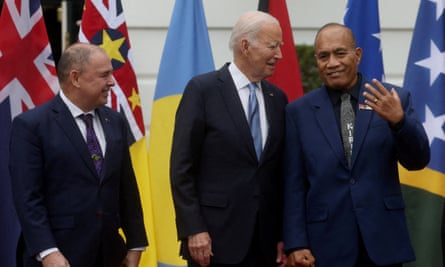Leaders from various Pacific nations will convene in the Cook Islands this week for the highly anticipated Pacific Islands Forum (Pif). This forum serves as the primary governing body for the region and will focus on climate change leading up to COP28, as well as navigating growing geostrategic competition, particularly with China.
The day before the summit, authorities verified that the heads of state of Papua New Guinea, Solomon Islands, Vanuatu, and New Zealand will not be present – reducing the likelihood of advancement on certain matters.
This is a summary of the forum and its significance.
Who comprises the group?
The Pacific Islands Forum (PIF) consists of 18 members, including Australia and New Zealand, which have the largest economies. The rest of the bloc is made up of countries from Melanesia, Micronesia, and Polynesia. Tokelau, a dependent territory of New Zealand, is also an associate member. Membership was previously only open to sovereign countries, but in 2016, French Polynesia and New Caledonia, both territories of France, became full members. The PIF also has “forum dialogue partners” from countries like the US, China, and the UK.
What is the purpose of the forum?
The forum serves as the primary governing body for the region’s political decisions. It is aided by a secretariat located in Suva, Fiji. In 2022, the leaders approved the 2050 Strategy for the Blue Pacific Continent, which is considered the guiding principle for the region and outlines a vision for the Pacific in regards to eight key areas, such as political leadership and regionalism.
In 2023, it is anticipated that leaders will approve the action plan for the 2050 strategy. This is expected to outline how regional organizations will assist member states in addressing important matters like adapting to climate change and promoting economic growth.
The leadership of the group changes every year among its members. Mark Brown, the current prime minister of Cook Islands, is currently serving as the chair of the Pif and will be hosting this year’s meeting. The Pif also has a “troika” of leaders consisting of the current chair, the past chair, and the next chair. This troika serves as an advisory group for the forum chair. The secretariat is led by a secretary general, currently held by Henry Puna, former prime minister of Cook Islands.
What are the main concerns to pay attention to?
The meeting taking place from November 6th to 10th in 2023 will include the attendance of Taneti Maamau, the president of Kiribati. His absence in 2022 was a low point in the relationship between regional leaders, caused by Micronesian frustration over the appointment of Puna as secretary general instead of their preferred candidate. However, it seems that the group has overcome this disagreement and there is optimism that reaffirming their commitment to making decisions collectively will help them navigate a crowded and complicated environment where China, the US, and other countries are vying for more access and influence.
The United States and China are both participants in a forum for dialogue. This may cause some tension, particularly for the US as it tries to diminish China’s growing influence. However, for Mark Brown, the prime minister of the Cook Islands and host of the forum, as well as the Pacific Islands Forum as a whole, the desired outcome is for partners to align their words and actions with the priorities of the Pacific.
Since the prime ministers of Papua New Guinea, Solomon Islands and Vanuatu will not be present, the Melanesian sub-group meeting will be significantly lacking in participation and therefore, almost insignificant. This lowers the likelihood of the Pacific Islands Forum as a whole being able to make substantial advancements on the matter of West Papua.
Anticipate differing viewpoints regarding deep ocean mining in the area. This topic has been a source of tension for a while and could escalate due to Brown’s backing of it as a means of expanding the economy. In the past, nations like Vanuatu and Fiji have urged for a temporary ban.
Australia plans to use this gathering to advocate for strong backing from Pacific nations in their proposal to host the COP31 climate negotiations in 2026. Despite some individuals, including former leaders of Pacific countries, urging for reluctance due to Australia’s current government’s lack of climate efforts, the decision is mostly finalized.
What is the history of the Pif?
In 1971, leaders from recently liberated Pacific nations came together to establish a forum. This was in response to their dissatisfaction with the South Pacific Commission, which was controlled by colonial powers such as the UK, France, and the US. Despite being present during discussions about their region, these leaders were unable to influence decisions. As a result, important matters like discontinuing nuclear testing and achieving self-determination were not addressed. In order to have more control, Pacific leaders, including Ratu Mara of Fiji, formed their own organization.

Do all members reach a consensus on all matters?
The process of reaching agreements, known as the “Pacific way,” is based on consensus. This can result in lengthy discussions during the leaders’ retreat, where the final communique for the annual meeting is determined. The forum has successfully addressed major issues, such as establishing a nuclear-free zone in the South Pacific. However, there have also been major disagreements, particularly with Australia, regarding efforts to reduce carbon emissions and address climate change.
-
Dr. Tess Newton Cain is the head of the Pacific branch at Griffith Asia Institute in Brisbane, Australia. She also works as a freelance journalist.
Source: theguardian.com
















